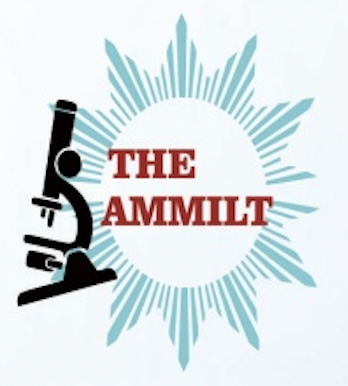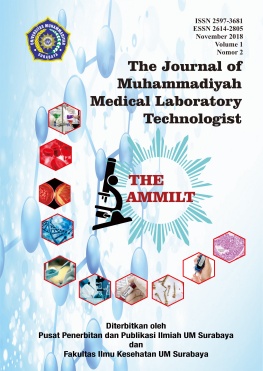Isi Artikel Utama
Abstrak
Apple manalagi is one type of apple that is consumed by many Indonesian people, because it tastes sweet, tasty, easy to get and the price is quite affordable. The Manalagi apple rind contains some phytochemical derivatives of polyphenols that have antibacterial effects. Shigella dysentriae is a bacillus bacteria that causes acute diarrhea (dysentery) in most people who lack hygiene. One alternative to prevent the disease is to use natural ingredients as an antibacterial. The aim of this research is to know the different growth of S. dysentriae bacteria in various concentrations of Manalagi apple rind (Malus sylvestris Mill.) In vitro. The type of this study was experimental consisting of 7 treatments with 4 repetitions. The sample consisted of 7 concentrations of manalagi apple rind (100%, 50%, 25%, 12.5%, 6.25%, 3.125%, and 0% (control) .The data analysis used ANOVA test with 5% 0.05). The results showed that the growth of S.dysentriae bacteria was only at 0% concentration; 3.125%; 6.25%; 12.5%; and 25%. While at concentrations of 50% and 100% there was no growth of S.dysentriae bacterial colonies. The conclusion of this study proves that Manalagi apple rind has antibacterial power against S.dysentriae bacteria.
Keywords: Shigella dysentriae, Manalagi Apple Rind (Malus sylvestris Mill).
Rincian Artikel
Referensi
- Afzadi MA. Genetic and biochemical properties of apples that affect storability and nutritional value. Introductory Paper at the Faculty of Landscape Planning, Horticulture and Agricultural Science. Swedish: SLU; 2012. p. 3
- Agusmawanti, P. “Perbandingan Daya Antibakteri Kumur Rebusan Gambir (Uncasia gambir) dengan Chlorhexidine 0,2% Terhadap Jumlah Koloni Bakteri Salivaâ€. J. Maj. Ilmiah Sultan Agung. Vol. 49 (2007) 1-9.
- Aini MN. 2015, Aneka Buah Berkhasiat Obat. Yogyakarta : Real Books
- Asromedika, 2011. Trimetoprim-Sulfametoksazol (Cotrimoxazole). http;//asromedika.blogspot.co.id/2011/08/Trimetoprim-Sulfametoksazol.html?=1
- Charde, M. S., Ahmed A., & Chakole, R. D. “Apple Phytochemicals for Human Benefitsâ€. Int. J. Pharm. Res. Vol. 1 (2) (2011) 1-8.
- Chusnie, T. P. T. & Lamb, A. J. “Antimicrobial Activity of Flavonoidâ€. Int. J. Antimicrob. Agent. Vol. 26 (2005) 343-356.
- Depkes, 2010, Pedoman Pemberantasan Penyakit Diare. Mentri Kesehatan Republik Indonesia. Diakses 28 April 2016 Available from : http://www.depkes.go.id/downloads/SK1216-01.pdf
- Depkes, 2011, Profil Kesehatan. Diakses 28 April 2016, http://www.depkes.go.id/folder/view/01/structure-publikasi-pusdatim-profil-kesehatan.html
- Dewi, F. K. “Aktivitas Antibakteri Ekstrak Etanol Buah Mengkudu (Molinda citrifolia, Linnaeus) Terhadap Bakteri Pembusuk Daging Segarâ€. Skripsi. Surakarta: Fakultas Matematika dan Ilmu Pengetahuan Alam Universitas Sebelas Maret (2010)
- Djajaningrat H & Misnadiarly. 2014. Mikrobiologi untuk klinik dan Laboratorium. Jakarta : PT Rineka Cipta
- Giomaro G, Karioti A, Bilia AR, et al. Polyphenols profile and antioxidant activity of skin and pulp of a rare apple from marche region (italy). Chemistry Central Journal; 2014;8:1
- Gunawan, I.W.A. “Potensi Buah Pare (Momordica Charantia L) Sebagai Antibakteri Salmonella typhimuriumâ€. Skripsi. Denpasar: Program Studi Pendidikan Biologi Fakultas Keguruan dan Ilmu Pendidikan Universitas Mahasaraswati (2009).
- Haryadi, 2012, Disentri basiler. Diakses 25 April 2016, http://digilib.ump.ac.id/files/disk1/2/jhptump-a-E.har-76-1-babi.pdf
- Heneman K, Zidenberg-Cherr S. Some facts about flavonols. Nutrition and Health Info-Sheet for Health Professionals: 2008: 1
- Hidayat, A.Aziz Alimul. 2010. Metode Penelitian Kesehatan. Health Books Publishing, Surabaya
- Jannata RH, Gunadi A, Ermawati T. Daya antibakteri ekstrak kulit apel manalagi (Malus sylvestris Mill.) terhadap pertumbuhan Streptococcus mutans. E-Jurnal Pustaka Kesehatan; 2014;2: 24,6
- Jawetz, E, Melnick, L.L, Adelburg, E. A.2008. Mikrobiologi Kedokteran. Jakarta : Penerbit Buku Kedokteran EGC
- Karunanindhi, A., Thomas, R., Belkum, A., & Neela, V. “In vitro anti-bacterial and antibiofilm activities of chlorogenic acid against clinical isolates of Stenotrophomonas maltophilia including the trimethoprim/sulfamethoxazole (TMP/SMX) resistant strainâ€. BioMed Research Int. Vol. 2013 (2012) 1-24.
- Kayser FH, Bienz KA, Eckert J, Zinkernagel RM. Color atlas of medical microbiology. New York: Thieme; 2005. p. 363
- Kementerian Kesehatan, 2013. Profil Kesehatan Tahun 2012. Diakses 30 April 2016, http://www.depkes.go.id/resources/doemnload/profil/PROFIL_KES_PROVINSI_2012/15_Profil_Kes.Prov.JawaTimur_2012.pdf
- Kusmiyati dan Agustini, N. “Uji Aktivitas Senyawa Antibakteri dari Mikroalga Porphyridium cruentumâ€. Biodiversitas Vol. 8 (1) (2007) 48 53.
- Nathania, Devi . 2008. Shigella dysentriae. Hal 1-2, diakses 30 april 2016, http://mikrobia.files.wordpress.com//
- Puspitasari, 2012. Muthuswamy, S,. dan Rupasinghe, H. P. V. “Fruit phenolics as natural antimicrobial agents: Selective antimicrobial activity of catechin, chlorogenic acid and phloridzinâ€. Journal of Food, Agriculture & Environment. Vol.5 (3&4) (2007) 81-85
- Redha. Flavonoid: struktur, sifat antioksidatif dan peranannya dalam sistem biologis. Jurnal Belian: 2010;9: 197
- Rustanti, E. “Uji Efektivitas Antibakteri dan Identifikasi Senyawa Katekin Hasil Isolasi dari Daun Teh (Camellia sinensis L. var. Assamicaâ€. Skripsi. Malang: Fakultas Sains dan Teknologi Jurusan Kimia Universitas Islam Negeri Malang (2009).
- Setiawan D & Felix A. 2013, Fakta Ilmiah Buah dan Sayur, Jakarta : Penebar Swadaya Grup
- Soedarto. 2009. Penyakit Menular Indonesia. Jakarta : CV Sagung Seto
- Sufrida Y, Irlansyah, Edi J, Mufatis W. Khasiat dan manfaat apel. Jakarta: Agro Media; 2007, pp. 22-3
- Sumono A, Wulan A. The use of bay leaf (Eugenia polyantha Wight) in dentistry. Dental Journal: 2008;41: 148-9
- Swastika A, 2014. Khasiat Buah dan Sayur Tumpas Segala Penyakit. Yogyakarta : Shira Media
- Wulandari A. Daya antibakteri ekstrak buah apel manalagi terhadap bakteri Salmonella thyposa. Jurnal Healthy Science AAKMAL: 2012;2: 1-3
Referensi
Afzadi MA. Genetic and biochemical properties of apples that affect storability and nutritional value. Introductory Paper at the Faculty of Landscape Planning, Horticulture and Agricultural Science. Swedish: SLU; 2012. p. 3
Agusmawanti, P. “Perbandingan Daya Antibakteri Kumur Rebusan Gambir (Uncasia gambir) dengan Chlorhexidine 0,2% Terhadap Jumlah Koloni Bakteri Salivaâ€. J. Maj. Ilmiah Sultan Agung. Vol. 49 (2007) 1-9.
Aini MN. 2015, Aneka Buah Berkhasiat Obat. Yogyakarta : Real Books
Asromedika, 2011. Trimetoprim-Sulfametoksazol (Cotrimoxazole). http;//asromedika.blogspot.co.id/2011/08/Trimetoprim-Sulfametoksazol.html?=1
Charde, M. S., Ahmed A., & Chakole, R. D. “Apple Phytochemicals for Human Benefitsâ€. Int. J. Pharm. Res. Vol. 1 (2) (2011) 1-8.
Chusnie, T. P. T. & Lamb, A. J. “Antimicrobial Activity of Flavonoidâ€. Int. J. Antimicrob. Agent. Vol. 26 (2005) 343-356.
Depkes, 2010, Pedoman Pemberantasan Penyakit Diare. Mentri Kesehatan Republik Indonesia. Diakses 28 April 2016 Available from : http://www.depkes.go.id/downloads/SK1216-01.pdf
Depkes, 2011, Profil Kesehatan. Diakses 28 April 2016, http://www.depkes.go.id/folder/view/01/structure-publikasi-pusdatim-profil-kesehatan.html
Dewi, F. K. “Aktivitas Antibakteri Ekstrak Etanol Buah Mengkudu (Molinda citrifolia, Linnaeus) Terhadap Bakteri Pembusuk Daging Segarâ€. Skripsi. Surakarta: Fakultas Matematika dan Ilmu Pengetahuan Alam Universitas Sebelas Maret (2010)
Djajaningrat H & Misnadiarly. 2014. Mikrobiologi untuk klinik dan Laboratorium. Jakarta : PT Rineka Cipta
Giomaro G, Karioti A, Bilia AR, et al. Polyphenols profile and antioxidant activity of skin and pulp of a rare apple from marche region (italy). Chemistry Central Journal; 2014;8:1
Gunawan, I.W.A. “Potensi Buah Pare (Momordica Charantia L) Sebagai Antibakteri Salmonella typhimuriumâ€. Skripsi. Denpasar: Program Studi Pendidikan Biologi Fakultas Keguruan dan Ilmu Pendidikan Universitas Mahasaraswati (2009).
Haryadi, 2012, Disentri basiler. Diakses 25 April 2016, http://digilib.ump.ac.id/files/disk1/2/jhptump-a-E.har-76-1-babi.pdf
Heneman K, Zidenberg-Cherr S. Some facts about flavonols. Nutrition and Health Info-Sheet for Health Professionals: 2008: 1
Hidayat, A.Aziz Alimul. 2010. Metode Penelitian Kesehatan. Health Books Publishing, Surabaya
Jannata RH, Gunadi A, Ermawati T. Daya antibakteri ekstrak kulit apel manalagi (Malus sylvestris Mill.) terhadap pertumbuhan Streptococcus mutans. E-Jurnal Pustaka Kesehatan; 2014;2: 24,6
Jawetz, E, Melnick, L.L, Adelburg, E. A.2008. Mikrobiologi Kedokteran. Jakarta : Penerbit Buku Kedokteran EGC
Karunanindhi, A., Thomas, R., Belkum, A., & Neela, V. “In vitro anti-bacterial and antibiofilm activities of chlorogenic acid against clinical isolates of Stenotrophomonas maltophilia including the trimethoprim/sulfamethoxazole (TMP/SMX) resistant strainâ€. BioMed Research Int. Vol. 2013 (2012) 1-24.
Kayser FH, Bienz KA, Eckert J, Zinkernagel RM. Color atlas of medical microbiology. New York: Thieme; 2005. p. 363
Kementerian Kesehatan, 2013. Profil Kesehatan Tahun 2012. Diakses 30 April 2016, http://www.depkes.go.id/resources/doemnload/profil/PROFIL_KES_PROVINSI_2012/15_Profil_Kes.Prov.JawaTimur_2012.pdf
Kusmiyati dan Agustini, N. “Uji Aktivitas Senyawa Antibakteri dari Mikroalga Porphyridium cruentumâ€. Biodiversitas Vol. 8 (1) (2007) 48 53.
Nathania, Devi . 2008. Shigella dysentriae. Hal 1-2, diakses 30 april 2016, http://mikrobia.files.wordpress.com//
Puspitasari, 2012. Muthuswamy, S,. dan Rupasinghe, H. P. V. “Fruit phenolics as natural antimicrobial agents: Selective antimicrobial activity of catechin, chlorogenic acid and phloridzinâ€. Journal of Food, Agriculture & Environment. Vol.5 (3&4) (2007) 81-85
Redha. Flavonoid: struktur, sifat antioksidatif dan peranannya dalam sistem biologis. Jurnal Belian: 2010;9: 197
Rustanti, E. “Uji Efektivitas Antibakteri dan Identifikasi Senyawa Katekin Hasil Isolasi dari Daun Teh (Camellia sinensis L. var. Assamicaâ€. Skripsi. Malang: Fakultas Sains dan Teknologi Jurusan Kimia Universitas Islam Negeri Malang (2009).
Setiawan D & Felix A. 2013, Fakta Ilmiah Buah dan Sayur, Jakarta : Penebar Swadaya Grup
Soedarto. 2009. Penyakit Menular Indonesia. Jakarta : CV Sagung Seto
Sufrida Y, Irlansyah, Edi J, Mufatis W. Khasiat dan manfaat apel. Jakarta: Agro Media; 2007, pp. 22-3
Sumono A, Wulan A. The use of bay leaf (Eugenia polyantha Wight) in dentistry. Dental Journal: 2008;41: 148-9
Swastika A, 2014. Khasiat Buah dan Sayur Tumpas Segala Penyakit. Yogyakarta : Shira Media
Wulandari A. Daya antibakteri ekstrak buah apel manalagi terhadap bakteri Salmonella thyposa. Jurnal Healthy Science AAKMAL: 2012;2: 1-3

